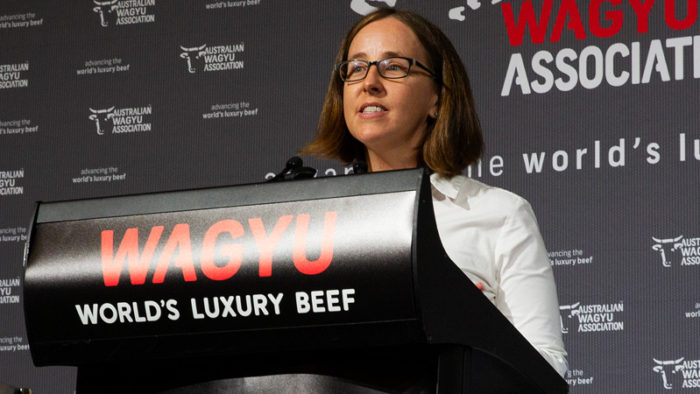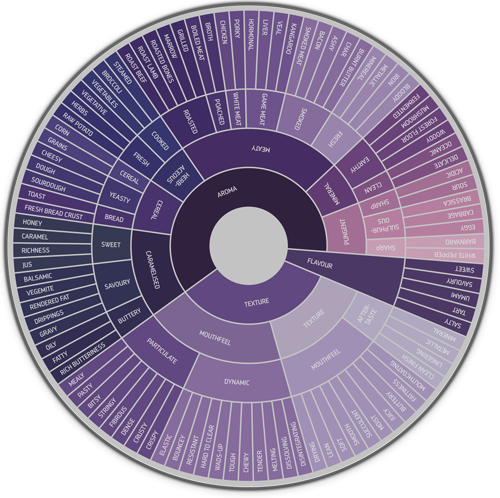Most of us would be hard-pressed to come up with 800 singular, descriptive words on any one food. But for a cooked piece of beef, that’s how many flavour volatiles it carries alone.

Food and flavour scientist Associate Professor Heather Smyth speaking at the 2022 WagyuEdge Conference.
Food and flavour scientist Associate Professor Heather Smyth (pictured right speaking at the 2022 WagyuEdge Conference), with 20 years of experience with premium food and beverages, understands the relationship between a food’s provenance story, its composition, and the sensory experience of enjoying a meal.
From craft beer, wine and coffee to seafood, dairy, and horticultural products, there are not many foods Smyth’s superior palette hasn’t worked with. Still, a recent project had her team of 12 expert taste tasters stand to attention – the Westholme Wagyu Flavour Wheel. Commissioned by AACo, the world’s first flavour wheel for beef is a sensory lexicon to describe the flavours and textures of the Westholme branded Wagyu.
From her Brisbane lab, Dr Smyth cooked different cuts with varying marbling scores – no oil, no salt – just beef. Her team of taste testers noted flavour, texture, aroma, and mouth feel. It’s been touted as an invaluable tool for the restaurant trade to enhance a high-end dining experience. Whether it’s planning menus, flavour combinations, sauces and side dishes, or accompanying wines, the flavour wheel enables chefs to educate beef lovers on the finer details of their meal. A comprehensive list of product descriptions for the different cuts and marbling grades also helps AACo in its marketing and package branding, with scope to further develop the language pool in the future.

Commissioned by AACo, the world’s first flavour wheel for beef is a sensory lexicon to describe the flavours and textures of the Westholme branded Wagyu.
“One of the great benefits for that company is to have a baseline understanding of what the quality parameters are in their beef,” Dr Smyth explains.
“When they are trying new diets or a new regime, they actually have a standard to compare to, to say, have we changed the flavour? Have we impacted the great quality that we have in any way? Are we improving it? Are we moving away?”
It’s a process Dr Smyth believes will continue to become more sophisticated over time, with Wagyu breeders motivated to select animals for specific parts of the flavour spectrum. She hopes other premium food producers will take note of AACo’s investment in sensory science to be able to objectively measure Wagyu’s sensory properties and diversity.
“Consumers already think that our Australian product is amazing. Let’s get on board and try and describe what our point of distinctiveness is in Australia, and communicate that to the rest of the world.”
In order to do this, the Australian Wagyu Association established the Wagyu Branded Beef Competition in 2012 to recognise and reward the most exciting and innovative Wagyu brands in our industry. It is the only branded beef competition supported by an independent breed representative organisation. The competition recognises and pays tribute to the hard work and dedication of all those involved in the Wagyu sector, inspiring and promoting Wagyu as the World’s Luxury Beef. The 2023 competition sees an expansion of categories with a Purebred Wagyu Steak and Open F1 Wagyu Steak classes added to the line up. Judging of the Wagyu beef is based on five criteria: visual appeal (raw and cooked), juiciness, flavour, aroma and the physical sensation in your mouth. Find out more!
